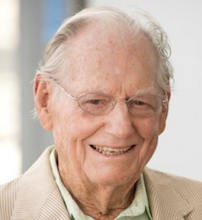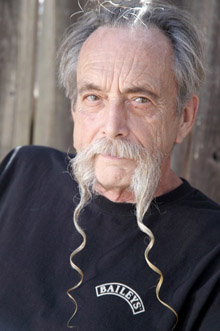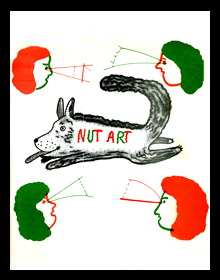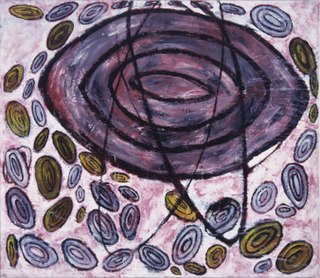Related Research Articles

Morton Wayne Thiebaud was an American painter known for his colorful works depicting commonplace objects—pies, lipsticks, paint cans, ice cream cones, pastries, and hot dogs—as well as for his landscapes and figure paintings. Thiebaud is associated with the pop art movement because of his interest in objects of mass culture, although his early works, executed during the fifties and sixties, slightly predate the works of the classic pop artists. Thiebaud used heavy pigment and exaggerated colors to depict his subjects, and the well-defined shadows characteristic of advertisements are almost always included in his work.

Melvin John Ramos was an American figurative painter, specializing most often in paintings of female nudes, whose work incorporates elements of realist and abstract art.

The Crocker Art Museum is the oldest art museum in the Western United States, located in Sacramento, California. Founded in 1885, the museum holds one of the premier collections of Californian art. The collection includes American works dating from the Gold Rush to the present, European paintings and master drawings, one of the largest international ceramics collections in the U.S., and collections of Asian, African, and Oceanic art. The Crocker Art Museum has been accredited by the American Alliance of Museums, a high standard for US museums.

Harry Eugene Fonseca was a Nisenan Native American artist, and illustrator. He was an enrolled citizen of the Shingle Springs Band of Miwok Indians.
Roy De Forest was an American painter, sculptor, and teacher. He was involved in both the Funk art and Nut art movements in the Bay Area of California. De Forest's art is known for its quirky and comical fantasy lands filled with bright colors and creatures, most commonly dogs.

Robert Brady is an American modernist sculptor who works in ceramics and wood. Born in Reno, Nevada, he has made his home in the San Francisco Bay Area for many decades. Brady is a multi-faceted artist who works in ceramics, wood, painting, and illustration, and is best known for his abstract figurative sculptures. Brady came out of the California Clay movement, and the Bay Area Arts scene of the 1950s and 1960s, which includes artists such as Peter Voulkos, Viola Frey, Stephen de Staebler, and Robert Arneson who was his mentor and teacher in college.

David Gilhooly, was an American ceramicist, sculptor, painter, printmaker, and professor. He is best known for pioneering the Funk art movement. He made a series of ceramic frogs called FrogWorld, as well as ceramic food, planets, and other creatures.

Funk art is an American art movement that was a reaction against the nonobjectivity of abstract expressionism. An anti-establishment movement, Funk art brought figuration back as subject matter in painting again rather than limiting itself to the non-figurative, abstract forms that abstract expressionists such as Jackson Pollock and Mark Rothko were depicting. The movement's name was derived from the jazz musical term "funky", describing the passionate, sensuous, and quirky. During the 1920s, jazz was thought of as very basic, unsophisticated music, and many people believed Funk was an unrefined style of art as well. The term funk also had negative connotations because the word had an association with a foul odor. Throughout the 1960s and 1970s, Funk was a popular art form, mainly in California's Bay Area in the United States. Although discussed as a cohesive movement, Funk artists did not feel as if they belonged to a collective art style or group. This is because while its artists shared the same attitudes and created similar works, they were not necessarily working together.

Robert H. Hudson is an American visual artist. He is known for his funk art assemblage metal sculptures, but he has also worked in painting and printmaking.
Gladys M. Nilsson is an American artist, and one of the original Hairy Who Chicago Imagists, a group of representational artists active during the 1960s and 1970s. She is married to fellow-artist and Hairy Who member Jim Nutt.
Roland Conrad Petersen is a Danish-born American painter, printmaker, and professor. His career spans over 50 years, primarily in the San Francisco Bay Area and is perhaps best-known for his "Picnic series" beginning in 1959 to today. He is part of the Bay Area Figurative Movement.

Clayton George Bailey, was an American artist who worked primarily in the mediums of ceramic and metal sculpture.

The Nut Artmovement was an artistic movement centered in Northern California, that flourished primarily in the late-1960s and early-1970s.
Otis William Oldfield was a San Francisco painter, printmaker and art educator.

Betty Graveen Bailey was an American multidisciplinary artist. She lived and worked in Contra Costa County, California, and was part of the Nut art movement.
Maija Peeples-Bright is a Latvian-born American and Canadian painter, ceramist, and arts educator. She is known as one of the pioneers of the Funk art movement in the San Francisco Bay Area in the 1960s. Maija Peeples-Bright has gone by the names Maija Zack, Maija Woof, Maija Bright, and Maija Peeples.
Dominic L. Di Mare is an American artist and craftsperson, known for his weaving, abstract mixed-media sculpture, watercolor paintings, cast paper art, and fiber art. His work touches on themes of personal spirituality. He is based in Tiburon, California.
Gregory Kondos (1923-2021) was an American painter known for his landscapes, particularly those of California's Sacramento Valley and coastlines. Kondos’ close friend and frequent collaborator, artist Wayne Thiebaud, called Kondos’s intuitive, unfettered technique “a kind of brush dancing." Throughout his career, Kondos frequently painted Yosemite, serving as artist-in-residence at the national park in 1990. His large-scale paintings, River’s Edge (1988) and Sutter’s Gold (2015) decorate the Sacramento International Airport.

Joan Moment is an American painter based in Northern California. She emerged out of the 1960s Northern California Funk art movement and gained attention when the Whitney Museum of American Art Curator Marcia Tucker selected her for the 1973 Biennial and for a solo exhibition at the Whitney in 1974. Moment is known for process-oriented paintings that employ non-traditional materials and techniques evoking vital energies conveyed through archetypal iconography. Though briefly aligned with Funk—which was often defined by ribald humor and irreverence toward art-world pretensions—her work diverged by the mid-1970s, fusing abstraction and figuration in paintings that writers compared to prehistoric and tribal art. Critic Victoria Dalkey wrote that Moment's methods combined chance and improvisation to address "forces embodied in a universe too large for us to comprehend, as well as the … fragility and transience of the material world."
Anthony 'Tony' Natsoulas is an American sculptor and contemporary artist. Numerous galleries and museums such as the Monterey Museum of Art, La Mirada, Sonoma Valley Museum of Art, and San Jose Museum of Art have exhibited Tony Natsoulas' work in the past; there are several large-scale pieces in public spaces.
References
- ↑ "The Candy Store, On View: August 24 – September 29, 1989". Schneider Museum of Art. Archived from the original on 2021-06-24. Retrieved 2021-06-19.
- 1 2 3 4 Linhares, Diana L. Daniels ; with essays by Philip E.; Frank, Patrick (2011). Clayton Bailey's world of wonders. Sacramento, CA: Crocker Art Museum. p. 8. ISBN 978-1-8840-3822-8.
{{cite book}}: CS1 maint: multiple names: authors list (link) - ↑ Goldman, Ed (2017-09-15). "The Spirit of the Candy Store". Sacramento Magazine. Retrieved 2021-06-19.
- ↑ Ollman, Leah (2018-07-03). "Review: This Candy Store wasn't a candy store: Remembering a California gallery that made art stars". Los Angeles Times. Archived from the original on 2018-07-03. Retrieved 2021-06-19.
- 1 2 Folsom Telegraph (16 March 2005). "Art From Adeliza's Candy Store at Museum". The Folsom Telegraph. Retrieved 22 March 2014.
- ↑ Smithsonian Archives of American Art. "Candy Store Gallery records". SmithsonianArchivesOfAmericanArt. Retrieved 22 March 2014.